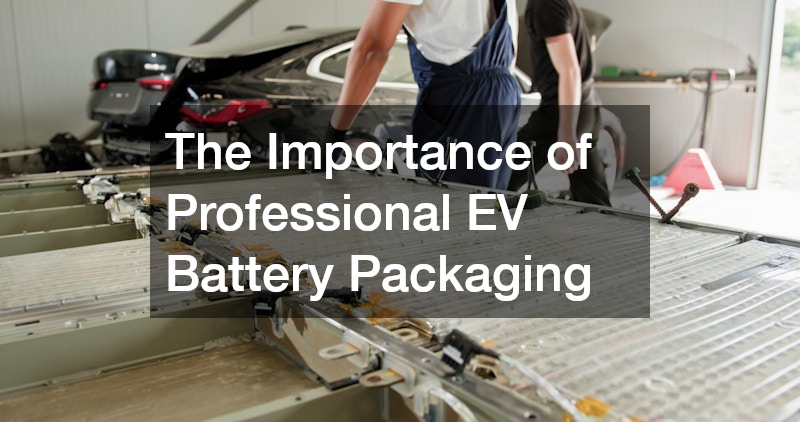The Importance of Professional EV Battery Packaging

The surge in electric vehicle (EV) adoption is transforming the automotive landscape. Central to this transformation is professional EV battery packaging, which plays a vital role in ensuring both the performance and safety of these vehicles.
The increase in EV demand underscores the need for high-quality battery packaging solutions. Proper packaging is critical to address not only safety and reliability concerns but also to enhance the sustainability of EV batteries overall.
Professional packaging solutions are at the core of tackling challenges in EV battery management. They are designed to offer protections that keep the batteries safe and effective over their life cycle.
1. Why Is Professional EV Battery Packaging Necessary?
1.1 Ensuring Safety and Reliability
Robust packaging solutions are essential to prevent potential hazards such as battery damage and leakage. Industry-specific standards have been established to guide the design and implementation of these solutions, safeguarding both vehicles and passengers.
Professional packaging solutions incorporate various protective layers that assist in containing chemical reactions within the battery. This containment is vital to prevent overheating and potential explosions under extreme conditions.
Advanced safety features embedded in modern packaging work synergistically to bolster the reliability of EV systems. Without these features, the likelihood of component failure escalates, posing significant risks.
1.2 Enhancing Battery Lifespan
Professional packaging extends the lifecycle of EV batteries by shielding them from physical and environmental stressors. This increased lifespan leads to better economic efficiency and sustainability for consumers.
Quality packaging acts as a barrier against environmental factors such as moisture and dust, which can degrade battery performance. By mitigating these threats, the packaging ensures that batteries maintain optimal conditions over time.
In protecting the battery against mechanical shock and vibration, professional packaging decreases the frequency and costs of maintenance. This protective feature prolongs battery life, improving the overall viability of the EV industry.
2. What Are the Key Elements of Effective EV Battery Packaging?
2.1 Materials Used in EV Battery Packaging
High-grade materials are chosen for their durability, weight, and thermal properties in EV battery packaging. Lightweight yet robust materials minimize the vehicle’s overall weight, enhancing its efficiency and performance.
Advanced polymers and metals are often employed for their exceptional insulation properties and corrosion resistance. These materials are capable of withstanding extreme temperatures and conditions, ensuring long-term viability.
Sustainability has also become a priority in material selection. The industry is increasingly turning to recyclable and biodegradable materials, striving to reduce the environmental impact of EV battery production.
2.2 Design and Construction Techniques
Innovative design strategies in EV battery packaging focus on maximizing efficiency and effectiveness. Engineers are continually exploring new methodologies to improve airflow management and thermal regulation.
Modern packaging designs incorporate modularity as a core attribute, allowing for easier battery replacement and repair. This modular approach not only reduces maintenance time but also contributes to the vehicle’s longevity.
Construction techniques have evolved to integrate complex geometries that enhance the battery housing’s strength. This evolution is crucial in maintaining the battery’s structural integrity under various operational stresses.
3. How Does Battery Packaging Impact EV Performance?
3.1 Thermal Management and Efficiency
Efficient thermal management is a cornerstone of effective battery packaging. Proper packaging helps maintain ideal temperature conditions, optimizing battery performance and safety.
Innovative thermal management techniques are constantly being developed to improve heat dissipation and control. These advancements lead to enhanced battery efficiency, translating into longer vehicle ranges.
Packaging solutions that integrate passive and active thermal systems are increasingly common. Such innovations are critical in ensuring that EVs operate effectively across different climates and weather conditions.
3.2 Structural Integrity and Vibration Resistance
The design of EV battery packaging is vital for protecting batteries from structural damage and vibrations. Shock-absorbing materials and designs are used to enhance the overall sturdiness of the battery pack.
Advanced materials and casing reinforcements guard against impacts and mechanical stress. By doing so, they preserve structural integrity, reducing the risk of damage during routine operations.
Developments in vibration-resistant technology help ensure stable battery operation even on uneven terrains. This aspect is crucial for maintaining consistent vehicle performance and reliability.
4. What Are the Environmental Considerations in EV Battery Packaging?
4.1 Sustainable Materials and Practices
Incorporating eco-friendly materials into EV battery packaging is a growing trend, reducing environmental footprints. Manufacturers are committed to using renewable resources and minimizing waste in production processes.
Recyclable materials are gaining importance in battery packaging, reflecting the industry’s shift toward sustainability. This approach not only benefits the environment but also enhances the appeal of EVs to environmentally conscious consumers.
4.2 End-of-Life Management and Recycling
End-of-life management for EV batteries includes strategic recycling efforts to reclaim useful materials. Efficient recycling systems are essential to minimize waste and support the sustainability of the EV market.
Research into battery disposal and recycling continues to advance, offering solutions to reclaim valuable components. These efforts help conserve resources and reduce the environmental impact of battery production.
5. How Is the Industry Innovating in EV Battery Packaging?
5.1 Technological Advancements in Packaging Solutions
Technological breakthroughs are driving significant improvements in EV battery packaging solutions. From better thermal management systems to ultra-lightweight materials, the evolution of technology is reshaping packaging strategies.
Automation and AI-integrated processes are optimizing packaging design and assembly. These technologies enable precision engineering, leading to consistent quality and enhanced performance.
5.2 Collaborations and Standards Development
Collaborations among automotive companies, material scientists, and environmental organizations play a role in advancing EV battery packaging. By partnering, stakeholders can pool resources and expertise to address complex challenges.
Developing industry standards is essential to harmonize practices and enhance product safety. Standardization ensures that all manufacturers adhere to consistent benchmarks, boosting consumer confidence in EV technology.
.







